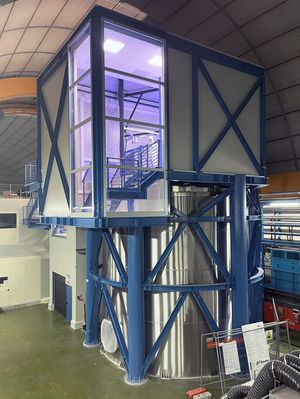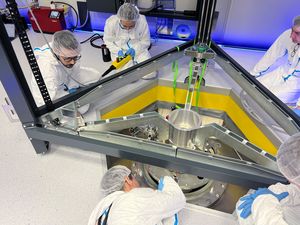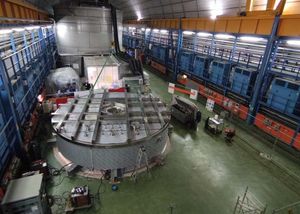COSINUS: Test of the DAMA experiment
Can the controversial dark matter signals of DAMA be confirmed?

In the search for the hypothetical dark matter particles, there are different approaches and methods. Many experiments involve searching directly for possible traces left behind by particles of dark matter when the atomic nuclei of normal visible matter are encountered. Examples are CRESST, Edelweiss, SuperCDMS, LUX, PandaX, DarkSide, and XENON-nT.
This also includes the DAMA/LIBRA experiment, which uses detectors made of sodium iodide. Thanks to its large detector mass (250 kg), it can detect another characteristic of dark matter particles. This entails a seasonal fluctuation in the observed signals – with a peak in June. The reason: The solar system revolves around the center of the Milky Way and the Earth around the sun. Depending on the position, the two relative speeds add up. As a result, our planet (and thus also the detectors) sometimes experiences a stronger or weaker particle wind.
However, the DAMA results are so far unconfirmed. In order to confirm the reliable detection of dark matter, other experiments must also be able to detect particle traces. Indeed, there are several projects (ANAIS in Spain, COSINE in Korea, and SABRE in Italy) in which scientists hope to reproduce the DAMA signals. However, none of them have been able to confirm the evidence for dark matter.
Combination of two detection methods
COSINUS will be added as a new testing instrument. The idea: COSINUS uses the same detector material as DAMA – sodium iodide. This is combined with a second detection channel – a special thermometer. When a dark-matter particle collides with the crystal, energy is deposited. This is manifested as a brief flash of light and a minuscule increase in temperature.
Over the next few years, COSINUS will be set up in the underground laboratory of the Gran Sasso (LNGS, Laboratori Nazionali del Gran Sasso) in Italy. The laboratory is located inside a massif, a natural bulwark against the interfering radiation from space. The experiment itself consists of 25 detectors surrounded by a seven-meter high water tank and thus protected from natural radioactivity. In the clean room above this setup, the detectors are prepared and installed in the experiment. The initial measurements are scheduled for 2022.
The project is led by a team from the Max Planck Institute for Physics, HEPHY, TU Wien, and INFN and GSSI (Italy). Other actors include SICCAS (China) and the Helsinki Institute for Physics (Finland).
COSINUS at the MPP
Phone number: +49 89 32354-extension
| name | function | extension | office | |
|---|---|---|---|---|
| Ackermann, Karlheinz | Engineering | ack | 445 | HOME OFFICE |
| Angloher, Godehard, Dr. | Senior Scientist | angloher | 445 | A.1.35 |
| Ansorge, Henrik | Student | ansorge | 560 | A.1.25 |
| Bharadwaj, Mukund | PhD Student | mukund | 560 | A.1.27 |
| Dittmar, Clemens Johannes Udo | PhD Student | dittmar | 497 | A.1.27 |
| Figueroa Falla, Pablo Jose | Student | pablof | 379 | A.1.33 |
| Gapp, Maximilian | Student | gapp | 560 | A.1.25 |
| Heim, Kilian | Student | kheim | 560 | A.1.25 |
| Hughes, Maximilian, Dr. | Postdoc | hughes | 582 | A.1.31 |
| Kellermann, Moritz | PhD Student | mkellerm | 497 | A.1.27 |
| Oswald-Kloi, Melanie | Secretary | moswald | 364 | A.2.43 |
| Schäffner, Karoline, Dr. | Senior Scientist | kschaeff | 445 | A.1.35 |
| Shera, Kumrie | PhD Student | kshera | 560 | A.1.25 |
| Stadler, Robert | Engineering | stadlerr | 330 | B.2.35 |
| Stahlberg, Martin, Dr. | Postdoc | mstahlbe | 379 | A.1.33 |
| Werner, Diana | Secretary | dwerner | 364 | A.2.43 |
| Zema, Vanessa, Dr. | Postdoc | vanezema | 582 | A.1.31 |
Model-independent comparison of annual modulation and total rate with direct detection experiments
F. Kahlhoefer, F. Reindl, K. Schäffner, K. Schmidt-Hoberg and S. Wild; JCAP05(2018)074
Results from the first cryogenic NaI detector for the COSINUS project
G. Angloher et al; 2017 JINST 12 P11007
A CsI low-temperature detector for dark matter search
G. Angloher et al.; Astroparticle Physics, Volume 84, Nov. 2016, arXiv:1602.08884
The COSINUS project: perspectives of a NaI scintillating calorimeter for dark matter search
G. Angloher et al.,; Eur. Phys. J. C, Volume 76, Aug. 2016, arXiv:1603.02214


![[Translate to English:] 3D design drawing of COSINUS in the Gran Sasso underground lab (LNGS) (Image: L. Giaffoni/U. di Sabatini/R. Stadler)](/fileadmin/_processed_/d/f/csm_COSINUS-setup_neu_01_1db23cbdd9.png)
